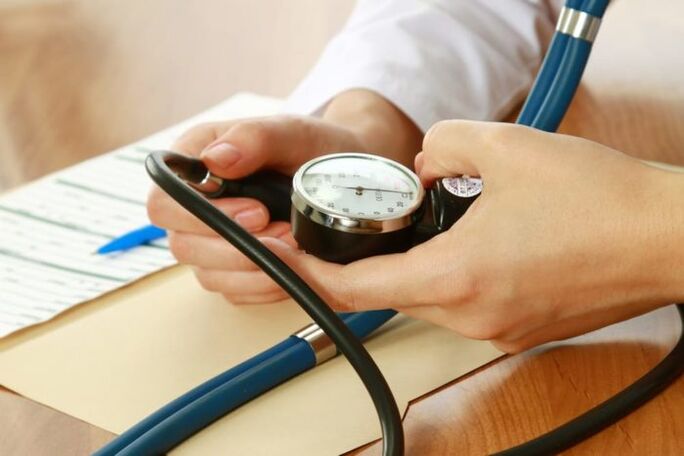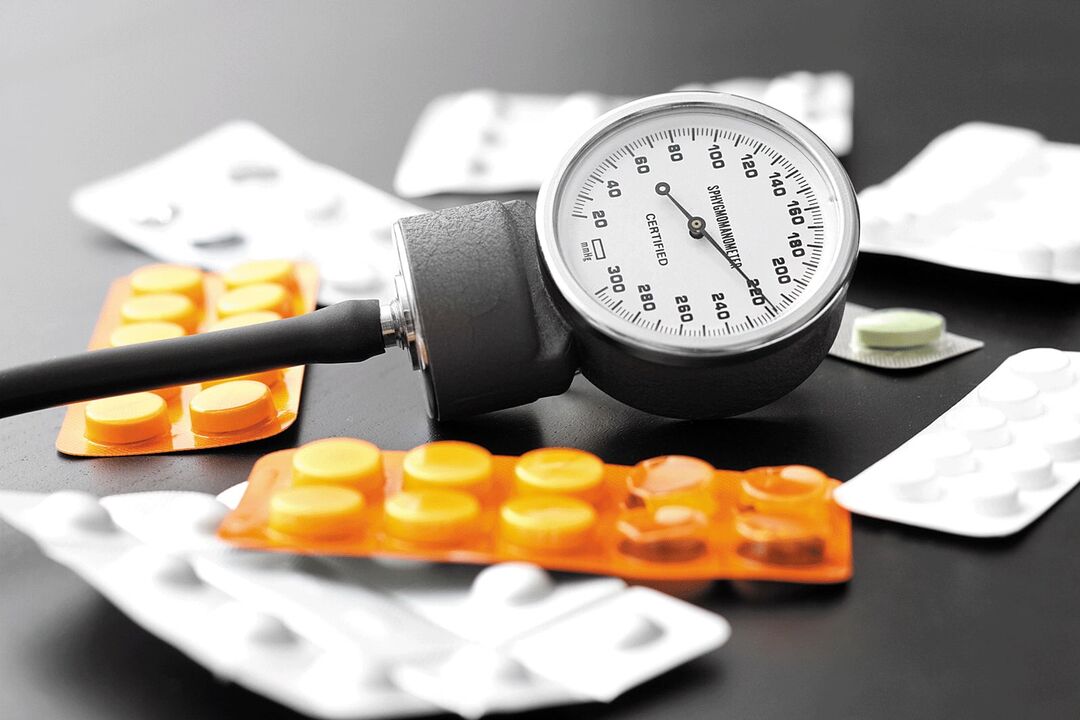The fact that there is a diagnosis of hypertension is only thought of when there is a constant increase in blood pressure on the face, or frequent jumps. At the same time, different levels of hypertension manifest themselves with different strengths. In the early stages of the disease, people are usually unaware of the development of the problem. Sometimes even a slight rise in temperature is given more attention than a violation of the condition when arterial hypertension develops. Types of pathology differ in the strength of symptom manifestations and the presence of corresponding disorders in the body. In fact, even without obvious symptoms, high blood pressure is no less dangerous than when it is coupled with various disorders in the body. Signs of hypertension include: trembling limbs, nausea, headache, flies in front of the eyes. All symptoms develop because of problems with blood flow to internal organs.

Stages of hypertension
The clinic of hypertension, according to the effect on the whole body and the severity of the accompanying symptoms, is classified into stage and severity. There are 3 levels. The division into stages helps the physician to systematize the diagnostic data obtained and select the right tactics to correct the patient’s condition.
1 level
The level of blood pressure in the first stage of hypertension does not exceed 159/99. This increase may continue for several days. Rest will help normalize blood pressure, eliminate stress. With the further development of pathology, it will not be so easy to restore the norm of stress.
At the developmental stage of the disease, there are no signs that it has an effect on the target organ. For this reason, arterial hypertension is often asymptomatic. Only sometimes when sleep is disturbed, headaches and implicit heartache can arise.
When conducting clinical diagnostics, a slight increase in the tone of the fundus arteries may be established. In the first stage of the disease, the risk of hypertensive crisis is minimal, often this condition occurs only due to the impact of external conditions on the body. The risk also increases in women during menopause. The early stages respond well to treatment. For this, lifestyle changes are usually sufficient. Medication is not always needed. With timely therapy and strict adherence to the doctor’s instructions, the prognosis will be favorable.
2 levels
This is the stage of active pathological changes in the vessels - severe hypertension. The pressure at the 2nd stage reached 179/109. Rest does not restore his level. Someone complains of very severe headaches, shortness of breath while exercising, worse sleep, dizziness and increased heart rate.
This stage is characterized by the development of the first signs of internal organs. The most common symptoms of hypertension are:
- signs of left ventricular hypertrophy;
- narrowing of the lumen of the retinal arteries;
- increased cholesterol in the blood;
- the presence of protein in the urine.
Stage 2 hypertension significantly increases the risk of dangerous complications that can lead to stroke. Without ongoing medical treatment, it will not be effective.
3 levels
This is a stage of disruption in the target organ due to pathological changes in the arteries and impaired blood flow throughout the body. Very severe hypertension in the 3rd degree. The last stage of hypertension is the most severe and widespread disorder that develops in the body, affecting target organs. The eyes, kidneys, brain and heart are most affected. Stress in the 3rd stage is stable, difficult to normalize even with drug treatment. Often there is a surge of up to 180/110 mm Hg. Art. and more. The symptomatology is similar to that occurring in the 2nd stage, but in addition it is accompanied by pathological manifestations of the affected organ. Memory is often impaired, heart rate is severely disturbed, visual acuity is reduced.
This stage is dangerous because it always affects the heart. Contractility and impulse conduction in the myocardium are impaired.
Degrees
With an increase in blood pressure and the absence of effect of the measures taken, it can be assumed that the disease is progressing. The optimal blood pressure level is 120/80. The norm for systolic pressure ranges from 120 to 129, and diastolic from 80 to 84. There is also a high normal pressure when a person is feeling well - up to 139/89 mm Hg. Art. In medicine, hypertension is classified into 3 degrees.
I have a degree
Grade 1 arterial hypertension is mild, it is characterized by a decrease in pressure and fluctuations from 140/90 to 159/99. The risk of crisis in such conditions is minimized, there are no symptoms of dysfunction of other organs and the central nervous system. To suppress the attack, in addition to taking special pills, you need to rest a little, try to avoid stress, walk and positive emotions have a positive effect on health.

If the systolic pressure does not exceed 159, and diastolic - 99 mm Hg. Art. , then the person is diagnosed with mild hypertension - the first stage. It is characterized by signs such as:
- headaches that get worse with energy;
- stabbing, pain on the left side of the chest, it radiating to the shoulder blades and under the arms;
- dizziness so strong that it may cause fainting;
- heart rate acceleration;
- black flies;
- tinnitus;
- sleep disorders.
A person is no longer aware of the listed symptoms if they develop continuously. Attacks of hypertension can start under the influence of stress and, with the right help, pass without consequences.
II degree
Level 2 hypertension begins to develop more actively. The pressure level has reached 160/100 - 179/109. Signs of hypertensive crisis develop - cold sweats appear, chills appear on the skin, facial skin turns red.
Symptoms of stage 2 disease include:
- transient cerebral ischemia - deterioration of blood flow to organs;
- increased creatinine concentration in the blood;
- narrowing of the arteries in the retina;
- increase in left ventricular size;
- protein in urine, found during test delivery;
- persistent fatigue;
- nausea;
- throbbing in the head;
- swelling of the face;
- severe sweating;
- damage to internal organs;
- numb fingers;
- blurred vision;
- crisis.
Medications are unable to normalize the patient's condition. Doctors pay attention not only to the level of stress, but also to the rate of progression of the disease. Second -degree hypertension affects the kidneys. Patients almost always complain of malaise.
III degree
Stage 3 hypertension is the most severe. When it does occur, vision decreases sharply, memory worsens, tachycardia often occurs and the risk of hypertensive crisis is high. Complications of this condition include thrombosis, encephalopathy, aneurysms, kidney and left ventricular failure of the heart, the formation of bruises throughout the body, and swelling of the optic nerve. The pathology is irreversible. With stage 3 hypertension, patients necessarily need outside help and care. The main symptoms of hypertension are:
- arrhythmia;
- walking instability;
- significant visual impairment;
- violation of blood flow to the brain, provoking paresis and paralysis;
- crisis, accompanied by confusion and impaired speech;
- sharp heart disease;
- blood production;
- limits of mobility and self -service ability;
- inability to communicate properly.
These symptoms indicate the development of hypertension and the involvement of new organs in the disease. Gradually, more irreversible complications develop.
Classification according to risk factors
Hypertension, first of all, is dangerous for its multiple and often irreversible complications. Most patients become disabled or die not specifically as a result of high blood pressure, but as a result of acute disorders in other organs triggered by it.
The most dangerous conditions are ischemic necrosis, cerebral hemorrhage, heart attack, renal failure. To avoid various complications associated with dysfunction of other organs, the doctor determines the level of risk during the examination. The level of risk is indicated by numbers from 1 to 4. It turns out that the diagnosis contains information about the level and risk of damage, for example, GB 2 degrees, risk 4.
Low risk (negligible)
Risk indicators for the development of these hypertensive complications are observed in women under 65 and men under 55 with mild hypertension at stage 1. Over the next 10 years, only 15% of people experience additional cardiovascular and vascular disorders due to hypertension. These patients are usually seen by general practitioners, as it does not make sense to visit a cardiologist and perform serious treatment.
When small risks still persist, one needs to make lifestyle changes over the next 6 months. This will lead to positive developments. If no results and a decrease in blood pressure can not be achieved, then it is recommended to change the tactics of managing the patient and implement drug therapy.
Simple risk
This group of patients includes hypertensive patients, whose blood pressure indicator does not exceed 179/110. As a rule, this person has 1 - 2 risk factors from the following:
- smoking;
- genetics;
- obesiti;
- high cholesterol concentrations;
- lack of physical activity;
- impaired glucose tolerance.
Over the next 10 years, dangerous cardiovascular pathology develops in 20% of cases. Organizing the right lifestyle is an important part of maintaining good health. Within 3-6 months, medication may not be given so that patients can restore their best health through lifestyle changes.
high risk
This risk group includes patients with an indicator of 179/110 or more with the presence of more than 2 predisposing factors. In addition, high risk is prescribed for people with target organ damage, diabetes mellitus, retinal vascular disorders and atherosclerosis.
There may also be no risk factors, but people with stage 3 hypertension are also at high risk. They must be treated by a cardiologist. The risk of complications is 30%. Lifestyle normalization is used only as an additional tactic against the background of taking specially selected medications. The most effective drug selection should be made as soon as possible.
Treatment approach
The main objective of hypertension treatment is to reduce stress and prevent consequences. Complete recovery is impossible, but adequate staging and treatment help stop the active progression of the pathology and minimize the risk of hypertensive crisis.
Drug therapy usually involves the use of antihypertensive drugs that inhibit the production of norepinephrine and its vasomotor activity. At the same time, the appointment of diuretics, antiplatelet agents, hypoglycemic, hypolipidemic and sedative drugs is required. If no results are expected, the combined effect of several antihypertensive drugs is carried out simultaneously.
In a hypertensive crisis, it is necessary to reduce stress within an hour after the attack, otherwise the risk of dangerous complications and death increases. In such cases, antihypertensive drugs are used by injection or drops.

Regardless of the degree and degree of dysfunction of the body, an important method of therapy is the normalization of nutrition, adherence to special diets. The diet must include foods enriched with magnesium, potassium, vitamins. It is required to limit the use of salt, to get rid of alcohol, fried and fatty foods. With obesity, the daily caloric content of the diet is reduced, sugar, pastries and other confectionery products are prohibited.
People with hypertension benefit from moderate physical activity - exercise therapy, swimming, walking. Therapeutic massage also has a beneficial effect on well -being with hypertension. Smoking is strictly prohibited, you should develop resistance to stress with the help of psychotherapy practices and relaxation techniques.
The effectiveness of complex therapy is evaluated according to several criteria:
- The short -term goal is the normalization of stress to a level where the patient feels well.
- The medium -term goal is to prevent the occurrence and active development of pathology in the target organ.
- The long -term goal is to prevent complications and prolong the patient’s life.
Hypertension is a disease that is easier to prevent than to fight it for the rest of your life, trying to reduce symptoms and prevent the condition from getting worse systematically. The earlier a diagnosis is made and the level of hypertension is determined, the more effective the treatment.



























